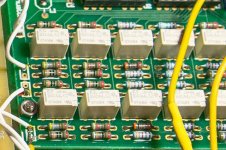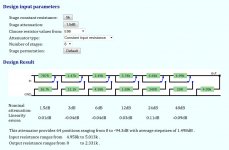My relay volume control have a "pop" noise when i turn it , is it a relay or other problem ? How to fix it ? many thx !!
I agree, it is almost always a small DC voltage on the signal line.
The DC changes with level and causes the pops.
Also known as zipper noise when you rapidly change levels.
It sometimes happens with some steps, not with others, that is because the effect is greatest with greatest steps.
For instance, going from -15dB to -16dB may involve engaging the -16dB relay and disengaging the -8, -4, -2 and -1 dB step relay.
Try to insert a capacitor between the signal and the input to the level control. If the pop is gone, it was the DC. Note that even a few mV can cause this!
jan didden
The DC changes with level and causes the pops.
Also known as zipper noise when you rapidly change levels.
It sometimes happens with some steps, not with others, that is because the effect is greatest with greatest steps.
For instance, going from -15dB to -16dB may involve engaging the -16dB relay and disengaging the -8, -4, -2 and -1 dB step relay.
Try to insert a capacitor between the signal and the input to the level control. If the pop is gone, it was the DC. Note that even a few mV can cause this!
jan didden
Or firmware change. First turn the relays "OFF" (max attenuation), and then enable the needed relays. This way the maximum "click" will be of the level of current volume setting.
Do you have diodes across relay's coils? There could be back-EMF, ruining the analog signal.
Do you have diodes across relay's coils? There could be back-EMF, ruining the analog signal.
Or firmware change. First turn the relays "OFF" (max attenuation), and then enable the needed relays. .
... which will give you two pops. I would attack the cause, clean up the DC on the signal line.
If your relays switch to "ON" faster than to "OFF" (given the "ON" increases output), you could get much more pronounced "POP" than two controlled "POP"s at lower volume...
Needs to be checked first to be viable solution, i've seen such solution as the "POP"s fighting method.
This one could be good for "01111111"->"10000000" transition.
Alternatively you can use a binary code without rough "01111111"->"10000000" transitions such as... ehm i forgot his name. The one which for every numeric increment changes just one bit. Then rearrange the relays/resistors to support such binary code.
Gray code, that's his name.
Emm... Is it feasible to implement it with resistive ladders? I am puzzled.
I guess the answer is "No" 🙂
Although someone did R2R DAC with it - http://www.google.com/patents?id=DOQ4AAAAEBAJ&printsec=abstract&zoom=4#v=onepage&q&f=false
Needs to be checked first to be viable solution, i've seen such solution as the "POP"s fighting method.
This one could be good for "01111111"->"10000000" transition.
Alternatively you can use a binary code without rough "01111111"->"10000000" transitions such as... ehm i forgot his name. The one which for every numeric increment changes just one bit. Then rearrange the relays/resistors to support such binary code.
Gray code, that's his name.
Emm... Is it feasible to implement it with resistive ladders? I am puzzled.
I guess the answer is "No" 🙂
Although someone did R2R DAC with it - http://www.google.com/patents?id=DOQ4AAAAEBAJ&printsec=abstract&zoom=4#v=onepage&q&f=false
Last edited:
If your relays switch to "ON" faster than to "OFF" [snip]
Yes, as long as the DC is there. You can change the way you switch a myriad ways until you are blue in the face: as long as there's DC you'll have pops.
jan
DACs and their ladders switch DC signal. And their glitches are fine enough to not sound as POPs...
And any analog signal is DC for certain frequency/timebase.
And any analog signal is DC for certain frequency/timebase.
yeah
every time I dismantled DAC chip with ladders , I found several relays in there
in fact , I'm not buying relays anymore - have enough DAC chips as donors

every time I dismantled DAC chip with ladders , I found several relays in there
in fact , I'm not buying relays anymore - have enough DAC chips as donors

Hi,
instead of opening an new thread I think this will fit in here.
I´ve also got a loud popping sound using an 6bit r2r volume control (1.5dB steps) with my X-BOSOZ.
There are only two positions where the pop occurs, going from -46.5 to -48dB (very loud) and from -48dB to -46.5 dB (loud). So from 011111 to 100000 and back.
The problem seems to be the 48dB jump (there´s no DC and no pop when there's no input signal)
The very loud pop could be avoided by changing the order of the relais switching (first switching the -48dB relais) but I´ve got no idea how I can avoid the loud pop as there will always be a 48dB jump in loudness regardless of when I switch the relais.
The volume control had 1dB steps before I changed it to 1.5dB and I´m not sure the pops where there before (occurring from -31 to -32dB) as I was´t in the range very often.
I changed it because -63,5dB was still too loud with some sources.
Any ideas if these pops are normal and how to avoid them without using a mute relais or making the steps smaller using 7 or 8 relais?
William
instead of opening an new thread I think this will fit in here.
I´ve also got a loud popping sound using an 6bit r2r volume control (1.5dB steps) with my X-BOSOZ.
There are only two positions where the pop occurs, going from -46.5 to -48dB (very loud) and from -48dB to -46.5 dB (loud). So from 011111 to 100000 and back.
The problem seems to be the 48dB jump (there´s no DC and no pop when there's no input signal)
The very loud pop could be avoided by changing the order of the relais switching (first switching the -48dB relais) but I´ve got no idea how I can avoid the loud pop as there will always be a 48dB jump in loudness regardless of when I switch the relais.
The volume control had 1dB steps before I changed it to 1.5dB and I´m not sure the pops where there before (occurring from -31 to -32dB) as I was´t in the range very often.
I changed it because -63,5dB was still too loud with some sources.
Any ideas if these pops are normal and how to avoid them without using a mute relais or making the steps smaller using 7 or 8 relais?
William
useful trick is to find specific relay position and solder 470-1000uF in parallel to coil , to slow it
sometimes simpler than changing software
sometimes simpler than changing software
Hi,
I wrote the software myself so that would not be the problem. It has to react differently depending on going up or down so slowing it down would only help one way.
William
I wrote the software myself so that would not be the problem. It has to react differently depending on going up or down so slowing it down would only help one way.
William
Relay resistor configuration can do this even with no DC. What is the schematic like and type or relays?
Do look for any DC coming in. Relays like this work well because they make contact quicker than break.
Hi Wayne,
Like i mentioned before, no DC and no noise when switching without a signal. I think I will try to change the 48dB step into 2x 24dB steps.
William
Like i mentioned before, no DC and no noise when switching without a signal. I think I will try to change the 48dB step into 2x 24dB steps.
William
two step volume change.
first switch attenuating relays, then switch un-attenuating.
somth like that. helps.
the idea behind is to always have less volume than required during switching transition.
So if you want to go from -47 to -48, you want to go thru -47, -?99?, -48. Currently you get -47, -?5?, -48.
**numericals are imprecise 🙂**
first switch attenuating relays, then switch un-attenuating.
somth like that. helps.
the idea behind is to always have less volume than required during switching transition.
So if you want to go from -47 to -48, you want to go thru -47, -?99?, -48. Currently you get -47, -?5?, -48.
**numericals are imprecise 🙂**
- Status
- Not open for further replies.
- Home
- Amplifiers
- Pass Labs
- "pop" noise in relay volume control

